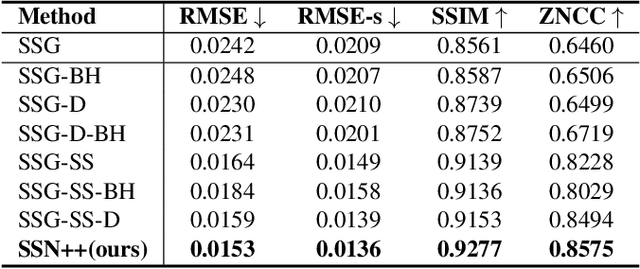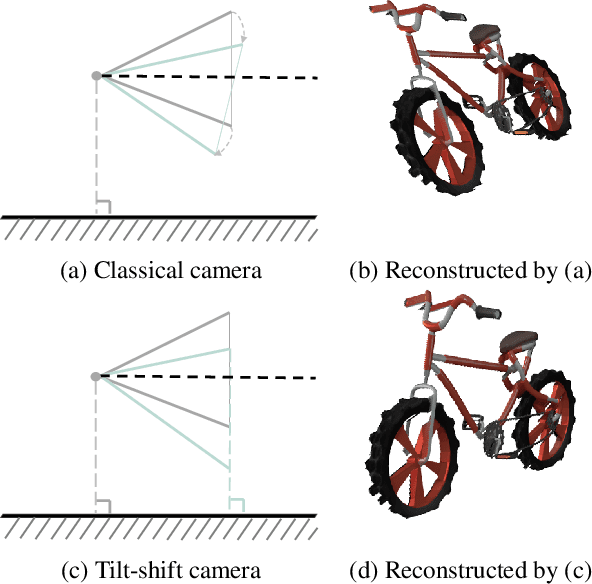Julien Philip
Adobe Research
Lux Post Facto: Learning Portrait Performance Relighting with Conditional Video Diffusion and a Hybrid Dataset
Mar 18, 2025Abstract:Video portrait relighting remains challenging because the results need to be both photorealistic and temporally stable. This typically requires a strong model design that can capture complex facial reflections as well as intensive training on a high-quality paired video dataset, such as dynamic one-light-at-a-time (OLAT). In this work, we introduce Lux Post Facto, a novel portrait video relighting method that produces both photorealistic and temporally consistent lighting effects. From the model side, we design a new conditional video diffusion model built upon state-of-the-art pre-trained video diffusion model, alongside a new lighting injection mechanism to enable precise control. This way we leverage strong spatial and temporal generative capability to generate plausible solutions to the ill-posed relighting problem. Our technique uses a hybrid dataset consisting of static expression OLAT data and in-the-wild portrait performance videos to jointly learn relighting and temporal modeling. This avoids the need to acquire paired video data in different lighting conditions. Our extensive experiments show that our model produces state-of-the-art results both in terms of photorealism and temporal consistency.
A Diffusion Approach to Radiance Field Relighting using Multi-Illumination Synthesis
Sep 17, 2024Abstract:Relighting radiance fields is severely underconstrained for multi-view data, which is most often captured under a single illumination condition; It is especially hard for full scenes containing multiple objects. We introduce a method to create relightable radiance fields using such single-illumination data by exploiting priors extracted from 2D image diffusion models. We first fine-tune a 2D diffusion model on a multi-illumination dataset conditioned by light direction, allowing us to augment a single-illumination capture into a realistic -- but possibly inconsistent -- multi-illumination dataset from directly defined light directions. We use this augmented data to create a relightable radiance field represented by 3D Gaussian splats. To allow direct control of light direction for low-frequency lighting, we represent appearance with a multi-layer perceptron parameterized on light direction. To enforce multi-view consistency and overcome inaccuracies we optimize a per-image auxiliary feature vector. We show results on synthetic and real multi-view data under single illumination, demonstrating that our method successfully exploits 2D diffusion model priors to allow realistic 3D relighting for complete scenes. Project site https://repo-sam.inria.fr/fungraph/generative-radiance-field-relighting/
* Project site https://repo-sam.inria.fr/fungraph/generative-radiance-field-relighting/
RRM: Relightable assets using Radiance guided Material extraction
Jul 08, 2024Abstract:Synthesizing NeRFs under arbitrary lighting has become a seminal problem in the last few years. Recent efforts tackle the problem via the extraction of physically-based parameters that can then be rendered under arbitrary lighting, but they are limited in the range of scenes they can handle, usually mishandling glossy scenes. We propose RRM, a method that can extract the materials, geometry, and environment lighting of a scene even in the presence of highly reflective objects. Our method consists of a physically-aware radiance field representation that informs physically-based parameters, and an expressive environment light structure based on a Laplacian Pyramid. We demonstrate that our contributions outperform the state-of-the-art on parameter retrieval tasks, leading to high-fidelity relighting and novel view synthesis on surfacic scenes.
Fast and Uncertainty-Aware SVBRDF Recovery from Multi-View Capture using Frequency Domain Analysis
Jun 25, 2024



Abstract:Relightable object acquisition is a key challenge in simplifying digital asset creation. Complete reconstruction of an object typically requires capturing hundreds to thousands of photographs under controlled illumination, with specialized equipment. The recent progress in differentiable rendering improved the quality and accessibility of inverse rendering optimization. Nevertheless, under uncontrolled illumination and unstructured viewpoints, there is no guarantee that the observations contain enough information to reconstruct the appearance properties of the captured object. We thus propose to consider the acquisition process from a signal-processing perspective. Given an object's geometry and a lighting environment, we estimate the properties of the materials on the object's surface in seconds. We do so by leveraging frequency domain analysis, considering the recovery of material properties as a deconvolution, enabling fast error estimation. We then quantify the uncertainty of the estimation, based on the available data, highlighting the areas for which priors or additional samples would be required for improved acquisition quality. We compare our approach to previous work and quantitatively evaluate our results, showing similar quality as previous work in a fraction of the time, and providing key information about the certainty of the results.
DATENeRF: Depth-Aware Text-based Editing of NeRFs
Apr 06, 2024Abstract:Recent advancements in diffusion models have shown remarkable proficiency in editing 2D images based on text prompts. However, extending these techniques to edit scenes in Neural Radiance Fields (NeRF) is complex, as editing individual 2D frames can result in inconsistencies across multiple views. Our crucial insight is that a NeRF scene's geometry can serve as a bridge to integrate these 2D edits. Utilizing this geometry, we employ a depth-conditioned ControlNet to enhance the coherence of each 2D image modification. Moreover, we introduce an inpainting approach that leverages the depth information of NeRF scenes to distribute 2D edits across different images, ensuring robustness against errors and resampling challenges. Our results reveal that this methodology achieves more consistent, lifelike, and detailed edits than existing leading methods for text-driven NeRF scene editing.
LightIt: Illumination Modeling and Control for Diffusion Models
Mar 25, 2024Abstract:We introduce LightIt, a method for explicit illumination control for image generation. Recent generative methods lack lighting control, which is crucial to numerous artistic aspects of image generation such as setting the overall mood or cinematic appearance. To overcome these limitations, we propose to condition the generation on shading and normal maps. We model the lighting with single bounce shading, which includes cast shadows. We first train a shading estimation module to generate a dataset of real-world images and shading pairs. Then, we train a control network using the estimated shading and normals as input. Our method demonstrates high-quality image generation and lighting control in numerous scenes. Additionally, we use our generated dataset to train an identity-preserving relighting model, conditioned on an image and a target shading. Our method is the first that enables the generation of images with controllable, consistent lighting and performs on par with specialized relighting state-of-the-art methods.
Materialistic: Selecting Similar Materials in Images
May 22, 2023Abstract:Separating an image into meaningful underlying components is a crucial first step for both editing and understanding images. We present a method capable of selecting the regions of a photograph exhibiting the same material as an artist-chosen area. Our proposed approach is robust to shading, specular highlights, and cast shadows, enabling selection in real images. As we do not rely on semantic segmentation (different woods or metal should not be selected together), we formulate the problem as a similarity-based grouping problem based on a user-provided image location. In particular, we propose to leverage the unsupervised DINO features coupled with a proposed Cross-Similarity module and an MLP head to extract material similarities in an image. We train our model on a new synthetic image dataset, that we release. We show that our method generalizes well to real-world images. We carefully analyze our model's behavior on varying material properties and lighting. Additionally, we evaluate it against a hand-annotated benchmark of 50 real photographs. We further demonstrate our model on a set of applications, including material editing, in-video selection, and retrieval of object photographs with similar materials.
JoIN: Joint GANs Inversion for Intrinsic Image Decomposition
May 18, 2023Abstract:In this work, we propose to solve ill-posed inverse imaging problems using a bank of Generative Adversarial Networks (GAN) as a prior and apply our method to the case of Intrinsic Image Decomposition for faces and materials. Our method builds on the demonstrated success of GANs to capture complex image distributions. At the core of our approach is the idea that the latent space of a GAN is a well-suited optimization domain to solve inverse problems. Given an input image, we propose to jointly inverse the latent codes of a set of GANs and combine their outputs to reproduce the input. Contrary to most GAN inversion methods which are limited to inverting only a single GAN, we demonstrate that it is possible to maintain distribution priors while inverting several GANs jointly. We show that our approach is modular, allowing various forward imaging models, that it can successfully decompose both synthetic and real images, and provides additional advantages such as leveraging properties of GAN latent space for image relighting.
Radiance Field Gradient Scaling for Unbiased Near-Camera Training
May 04, 2023Abstract:NeRF acquisition typically requires careful choice of near planes for the different cameras or suffers from background collapse, creating floating artifacts on the edges of the captured scene. The key insight of this work is that background collapse is caused by a higher density of samples in regions near cameras. As a result of this sampling bias, near-camera volumes receive significantly more gradients, leading to incorrect density buildup. We propose a gradient scaling approach to counter-balance this bias, removing the need for near planes, while preventing background collapse. Our method can be implemented in a few lines, does not induce any significant overhead, and is compatible with most NeRF implementations.
PixHt-Lab: Pixel Height Based Light Effect Generation for Image Compositing
Feb 28, 2023



Abstract:Lighting effects such as shadows or reflections are key in making synthetic images realistic and visually appealing. To generate such effects, traditional computer graphics uses a physically-based renderer along with 3D geometry. To compensate for the lack of geometry in 2D Image compositing, recent deep learning-based approaches introduced a pixel height representation to generate soft shadows and reflections. However, the lack of geometry limits the quality of the generated soft shadows and constrain reflections to pure specular ones. We introduce PixHt-Lab, a system leveraging an explicit mapping from pixel height representation to 3D space. Using this mapping, PixHt-Lab reconstructs both the cutout and background geometry and renders realistic, diverse, lighting effects for image compositing. Given a surface with physically-based materials, we can render reflections with varying glossiness. To generate more realistic soft shadows, we further propose to use 3D-aware buffer channels to guide a neural renderer. Both quantitative and qualitative evaluations demonstrate that PixHt-Lab significantly improves soft shadow generation.
 Add to Chrome
Add to Chrome Add to Firefox
Add to Firefox Add to Edge
Add to Edge